|
|
Post by Dave Homewood on May 21, 2014 12:36:15 GMT 12
The crumpled tail Harvard is not NZ1037. I linked this to Brendon Deere's Facebook page and he has replied:
"NZ1037 only had three minor incidents during its RNZAF career and never this level of damage. Remember that many of the Harvards were received with wooden rear fuselages during the war and later converted to metal rear sections as part of the "2star" classification which NZ1037 has. Mk3s may have been metal from the start - not sure. 1037 also has the "starting pedal" whereas the RNZAF Historic Flight NZ1015 which is a Mk 3 has the panel starting switches.
Well known warbird pilot Gavin Trethewey had an engine loss of power on take off incident in 1037 at Wigram in his RNZAF training days and received a commendation for his handing of the incident."
|
|
|
|
Post by errolmartyn on May 21, 2014 13:23:40 GMT 12
NZ1037 - Collision on the ground 19.6.45 at Ohakea AC/REP No. 25/2/2240 NZ1024 I've not viewed the full accident report but the accident card summarising this event gives the date as 1 8/6/45 (time 0245). Errol |
|
|
|
Post by Damon on May 21, 2014 13:46:22 GMT 12
I think Harvard NZ1052 also has the pedel type starter .Also in recent years (late 1990's? ) Gavin Trethewey also had a broken engine cylinder on NZ1092 and again brought it safely home to AR. Safe hands I guess.
|
|
|
|
Post by baz62 on May 21, 2014 15:26:00 GMT 12
Well that last digit is certainly either a 3 or an 8. I also note that the fusleage is unpainted. The photos I saw of NZ1040 was in just this scheme upon delivery, unpainted with RAF style roundels and finflash (which is the scheme you mentioned for NZ1048 Dave). However I notice that NZ1043 was struck by NZ1014 while taxying in 1945 at Ohakea and was written off the books that same year. Looking at the tail I'd say a spinning prop just may have been at work here. Sounds like a good candidate.
|
|
|
|
Post by errolmartyn on May 21, 2014 18:09:23 GMT 12
Well that last digit is certainly either a 3 or an 8. I also note that the fusleage is unpainted. The photos I saw of NZ1040 was in just this scheme upon delivery, unpainted with RAF style roundels and finflash (which is the scheme you mentioned for NZ1048 Dave). However I notice that NZ1043 was struck by NZ1014 while taxying in 1945 at Ohakea and was written off the books that same year. Looking at the tail I'd say a spinning prop just may have been at work here. Sounds like a good candidate. The accident cards for these two has this to say: 'Taxying at night - pilot was taxying along taxiway behind aircraft NZ1043. On noticing aircraft ahead had practially stopped, he applied brake. The aircraft swung to port, colliding with NZ1043. (NZ1014 - Major repair: NZ1043 - Major overhaul.)' The event took place at Ohakea at 2000 on 27 June 1945. I don't know that this fits the aircraft pictured, however, as the damage appears to indicate the aircraft striking it was turning to starboard, not to port, unless perhaps the photo has been laterally inverted. Also, one would expect it to be NZ1043 that required the 'Major repair', rather than the Major overhaul? Errol |
|
|
|
Post by baz62 on May 21, 2014 18:35:03 GMT 12
(NZ1014 - Major repair: NZ1043 - Major overhaul.)' The event took place at Ohakea at 2000 on 27 June 1945. I'm still picking it's NZ1043. They must have changed their mind about the major overhaul on 1043 as she was written off the books at Ohakea August 1945 according to ADF serials. |
|
|
|
Post by baronbeeza on May 21, 2014 18:38:36 GMT 12
I think Baz may be on to it all the same.
That accident description may well tally with the damage we are seeing in the pic. It may be the stbd wing has struck a swinging blow to the rudder and rear as it has swung to the Port. The prop may not have played such a large part until possibly the left horizontal stab and elevator were fed into it.
|
|
|
|
Post by suthg on May 21, 2014 19:29:51 GMT 12
baronbeeza - Smart looking useful trailer there!! LOL! Oops, particular post and photo I was replying to no longer exists... - oh it was last post previous page... too slow to reply.
|
|
|
|
Post by davidd on May 21, 2014 23:00:20 GMT 12
Nothing to do with Harvards I am afraid, but harking back to the episode featuring the mysterious airfield by the sea/lake which turned out to be Grassmere, I see that a much larger aircraft visited this small field, and must have had a spectacular arrival there. This was Hudson NZ2026 on 21st November 1944, which ended up in the mud with it undercarriage still retracted, and both props considerably bent, and its inflated dinghy resting under the port wing. Not exactly certain why this aircraft ended up in this position, but one begins to suspect some sort of low flying incident. There are some suspicious looking low clay cliffs in the background. Several official photos were taken of this distressed Hudson, which was ultimately salvaged and returned to service. The aircraft was still fitted with a full set of ASV arrays on its rear fuselage and the colour scheme was full camouflage (presume blue grey and dark green) with white-barred roundels, but no code letters at all. It was supposedly on the strength of the Central Flying School, then based at Woodbourne. Perhaps somebody has some clear prints of this incident that they could post here, or more properly on the Hudson pile (if they are not already there).
David D
|
|
|
|
Post by errolmartyn on May 22, 2014 0:09:37 GMT 12
Nothing to do with Harvards I am afraid, but harking back to the episode featuring the mysterious airfield by the sea/lake which turned out to be Grassmere, I see that a much larger aircraft visited this small field, and must have had a spectacular arrival there. This was Hudson NZ2026 on 21st November 1944, which ended up in the mud with it undercarriage still retracted, and both props considerably bent, and its inflated dinghy resting under the port wing. Not exactly certain why this aircraft ended up in this position, but one begins to suspect some sort of low flying incident. There are some suspicious looking low clay cliffs in the background. Several official photos were taken of this distressed Hudson, which was ultimately salvaged and returned to service. The aircraft was still fitted with a full set of ASV arrays on its rear fuselage and the colour scheme was full camouflage (presume blue grey and dark green) with white-barred roundels, but no code letters at all. It was supposedly on the strength of the Central Flying School, then based at Woodbourne. Perhaps somebody has some clear prints of this incident that they could post here, or more properly on the Hudson pile (if they are not already there). David D From the accident card: When recovering from stalling practice at 5,000’, engines failed to respond. Instructor took over controls but cockpit check failed to reveal cause of failure. As height was being lost rapidly he was unable to carry out further checks, so he closed throttles and made a successful forced landing with undercarriage retracted. Faulty technique: viz. Misuse of the engine controls. The pilot being inexperienced on the type confused the mixture and throttle levers in such a manner that on recovery from the stall he eased the mixture control forward towards “Idle Cut Off” being under the impression that he was manipulating the throttle. Neither of the pilots were very efficient in their cockpit drill. No action has been taken as this accident is due to inexperience. The captain (20hrs on type and 1850hrs total solo) was Flt Lt NZ411481 Melville William Waters. His ‘Pupil’ was Flt Lt NZ40902 John Herbert Penny. Fg Off NZ421029 Edwin Pattison Booth Ebbett was also on board, as ‘Passenger’ The incident occurred at 1405 during dual instruction. 'Extent of Damage: Engines & airframes - minor repair (A)'. Errol |
|
|
|
Post by planecrazy on May 22, 2014 9:34:30 GMT 12
Sorry is this is a silly question on the very first page of this thread is a Harvard in
Air New Zealand markings, are the cut down 44 gallon drums just hold downs or
did they use them when they do a static run up to power.
Would imagine they would be hard to move, regardless great reuse of would be
rubbish, love recycling.
|
|
|
|
Post by Dave Homewood on May 22, 2014 9:40:36 GMT 12
Well that solves a long time mystery. A photo of that ditched Hudson appeared in New Zealand Wings around 29 years ago, showing it lying in the mud with the raft inflated. They were asking for details as even Ross Macpherson had no idea. I never was able to get to the bottom of that one. Now we know. Thanks David and Errol.
|
|
|
|
Post by NZ1009 on May 23, 2014 7:58:37 GMT 12
So the original entry in the photo album is incorrect (ground collision between NZ1024 and NZ1037) which leaves the two possibilities others have mentioned and summarised below. Of these, given the damage (and lack of damage) shown in the original photo, I think Baz62's suggestion that it is NZ1043 after being struck by NZ1014 is the most likely. NZ1014 seems to have been a serial offender as it was involved in ground collisions 3 times in 3 years (1943, 1944, 1945). -------------------------------------------------------------------------------------------- From ADF-Serials: NZ1048 88-13905 Mk IIA 41-33764 Previously EX791. From RAF/FAA lend-lease allocations. Shipped to New Zealand on "B.J. Wheeler" in July 1943 and assembled at Hobsonville. BOC 19 July 1943. With No.2 FOTU, Ohakea late 1944. Crashed at Raumai after midair collision with NZ1035 during training flight at 0930 hours on 04 August 1945. The aircraft tail was destroyed in the accident and it spiralled into farmland near Ohakea. Sergeant Warren Sharpe killed. Written off books Ohakea 21 August 1945. From Errol: Sat 4 Aug 1945 NEW ZEALAND Air-air practice attacks 2 Operational Training Unit, RNZAF (Ohakea) Harvard IIA NZ1035 - on a diving pass at 0930 the port wing struck the tail of the target aircraft (NZ1048). The latter’s tail disintegrated, the aircraft spiralling into the ground on Mr Dalrymple’s farm at Parewanui, SW of Ohakea, where it burst into flames. With part of its port wing sheered off, NZ1035 entered a shallow spiral, recovered momentarily, then flicked over and crashed about 1000 yards away on the same property. The pilot is buried at Christchurch. Pilot: NZ4313159 Sgt Charles Roderick GRAY, RNZAF - Age 20. 138hrs solo (85 on Harvard) Gray’s father, Douglas Wanklyn Gray, was a First World War pilot who served in the RNAS and RAF, and, for a short time afterwards, the Canterbury (NZ) Aviation Company. 2 Operational Training Unit, RNZAF (Ohakea) Harvard IIA NZ1048 - collided in mid-air with NZ1035 as described in the previous entry. The pilot is buried at Otahuhu. Pilot: NZ4310378 Sgt Warren Selwyn SHARPE, RNZAF - Age 20. 148hrs solo (93 on Harvard) -------------------------------------------------------------------------------------------- From ADF-Serials: Previously EX746. From RAF/FAA lend-lease allocations. Shipped to New Zealand on "James Hogg" in June 1943 and assembled at Hobsonville. BOC 26 June 1943. Struck by NZ1014 while taxying at Ohakea 28 June 1945. Written off books at Ohakea 09 August 1945. From Errol: The accident cards for these two has this to say: 'Taxying at night - pilot was taxying along taxiway behind aircraft NZ1043. On noticing aircraft ahead had practially stopped, he applied brake. The aircraft swung to port, colliding with NZ1043. (NZ1014 - Major repair: NZ1043 - Major overhaul.)' The event took place at Ohakea at 2000 on 27 June 1945. -------------------------------------------------------------------------------------------- The following photo (RNZAF Museum) shows NZ971 after it had a go at Kittyhawk NZ3017 on 26-Jun 1942 at Ohakea. 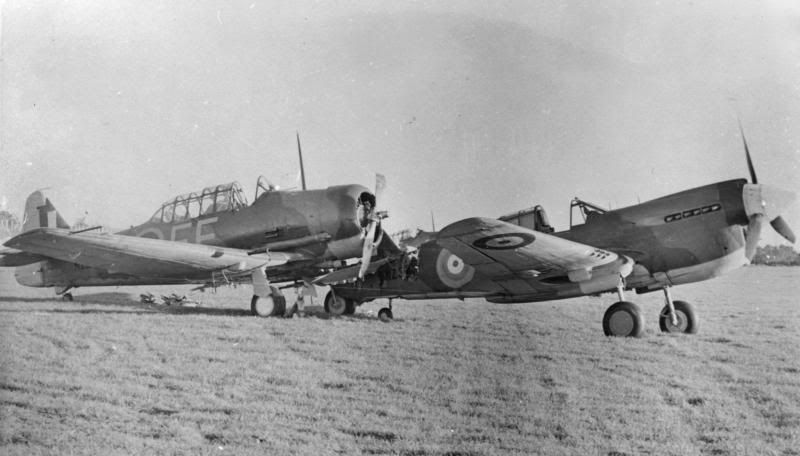 NZ918 and NZ932 (RNZAF Museum). 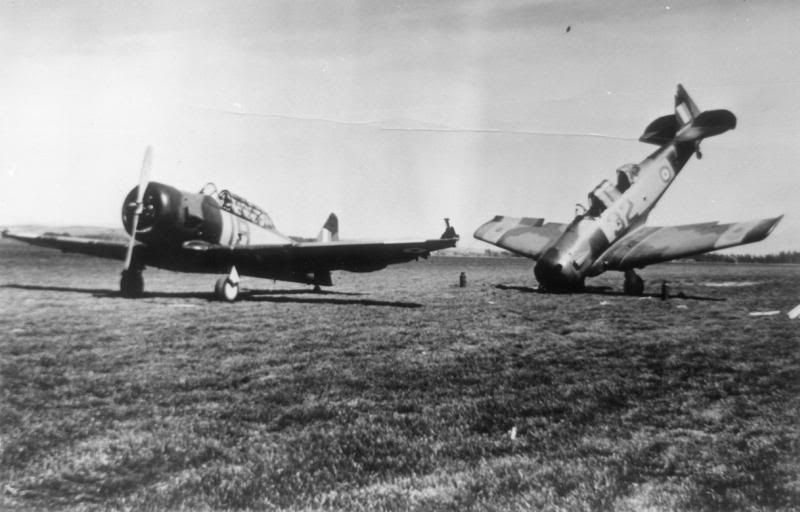 |
|
|
|
Post by planecrazy on May 23, 2014 9:45:06 GMT 12
I guess others have noticed I wonder how the tip of the rudder on the rh machine got damaged?
|
|
|
|
Post by Damon on May 23, 2014 10:09:31 GMT 12
Probably not really damaged. The rudder is deflected to the right which may give the appearance of damage.NZ918's rudder is neutral in position. Harvard's have had a hard life haven't they!
|
|
|
|
Post by davidd on May 24, 2014 14:39:26 GMT 12
Just a small correction to Errol M's reply dated 22 May. The instructor in charge of Hudson NZ2026 in November 1944 was actually F/L Melville William WATERS (NZ411481), a permanent staff instructor with CFS at Woodbourne since just 6/11/44; however he had been supernumerary here since 1/6/44, although the reason for this arrangement is unknown to me. On the other hand, the afore-mentioned E B Waters was by this time a Squadron Leader, and so far as I know he had been staff officer (not usually flying let alone instructing) for several years. To get back to M W Waters, he had graduated with 3 FTS at Ohakea on 16/8/41, and was almost immediately shipped off to Singapore. He returned to NZ (as did do many others) in late March 1942, then trained as a flying instructor at Tauranga. Most of his subsequent instructing was undertaken at 1 SFTS Wigram from June 1942 onwards, so he was certainly a well-experienced twin-engined pilot by the time he arrived at Woodbourne.
David D
|
|
|
|
Post by errolmartyn on May 24, 2014 15:15:23 GMT 12
Just a small correction to Errol M's reply dated 22 May. The instructor in charge of Hudson NZ2026 in November 1944 was actually F/L Melville William WATERS (NZ411481), a permanent staff instructor with CFS at Woodbourne since just 6/11/44; however he had been supernumerary here since 1/6/44, although the reason for this arrangement is unknown to me. On the other hand, the afore-mentioned E B Waters was by this time a Squadron Leader, and so far as I know he had been staff officer (not usually flying let alone instructing) for several years. To get back to M W Waters, he had graduated with 3 FTS at Ohakea on 16/8/41, and was almost immediately shipped off to Singapore. He returned to NZ (as did do many others) in late March 1942, then trained as a flying instructor at Tauranga. Most of his subsequent instructing was undertaken at 1 SFTS Wigram from June 1942 onwards, so he was certainly a well-experienced twin-engined pilot by the time he arrived at Woodbourne. David D Thanks David. I have corrected my post accordingly. Errol |
|
|
|
Post by davidd on May 24, 2014 16:35:17 GMT 12
Just to throw another cat among the pigeons, I have it that Harvard 932 WAS damaged at Wigram on 2/10/44, at 2200 hours, but no other aircraft was involved! The instructor and pupil pilot aboard NZ932 apparently taxied into a glide slope indicator during night flying (landing exercise). Mentioning no names, but this was considered to be another case of "insufficent lookout", "carelessness"", and "Log Book Endorsement", the latter being of the "Red" variety. As one would not expect that this aircraft would still have been out on the aerodrome the following day without having being moved, I would suggest that this photo actually illustrates another incident entirely. For instance, if this aircraft had hit a glide slope indicator, should it not still be present in the photograph? Also why is the other Harvard (NZ918) not mentioned in the official report of the 2/10/44 incident? To advance this theory, no such incident (the presumed collision between 918 and 932) is mentioned in what I consider to be a fairly complete listing of wartime Harvard accidents in NZ, and I can only suggest that no official report on this incident was rendered as one would expect, although I cannot explain why this should have happened. Any comments from the gallery please, or does anybody have a possible date for the alternative theory? The colour scheme worn by these two Harvards also suggests an earlier date, perhaps in 1943 or early 1944, which would indicate a Woodbourne scenario. In October 1944, most of the Harvards at Wigram should have been finished in overall yellow, a process which was first ordered as early as November 1943.
David D
|
|
|
|
Post by NZ1009 on May 25, 2014 14:33:23 GMT 12
I have amended the entry for NZ918 / NZ932 collision. The accident records I have access to have less detail
than Davids and just state taxy accident for NZ932 but there is no associated aircraft so I just presumed it
was NZ918. Obviously not a smart idea to guess and also given the paint job and the low range of hills to the
left of NZ918.
Am a little intrigued as to what a Glide Slope Indicator would be at Wigram in 1944?
|
|
|
|
Post by NZ1009 on May 25, 2014 14:34:21 GMT 12
Continuing along with the theme of Harvards having a hard time (RNZAF Museum). I think the descriptions are correct? NZ914 27-Feb 1943 Woodbourne Landed undercarriage up 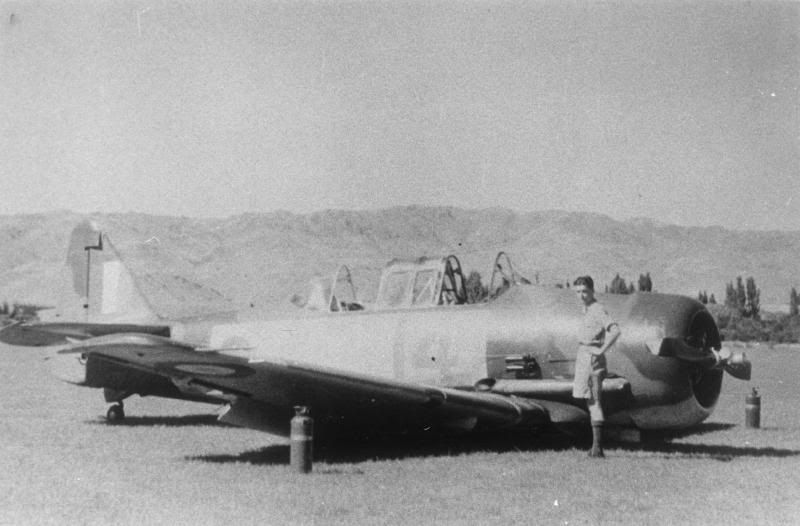 My accident records only go to 1957 and this is clearly after that. 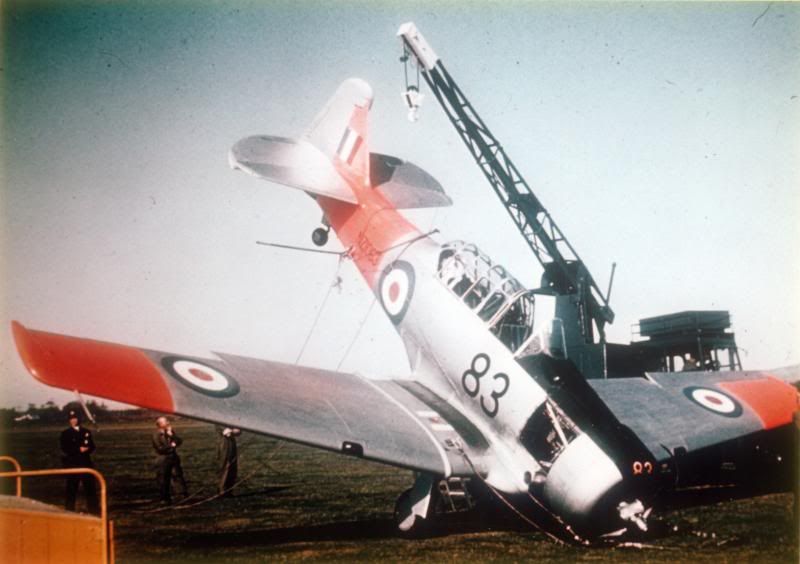 NZ1096 2-Sep 1949 Wigram Undercarriage retracted 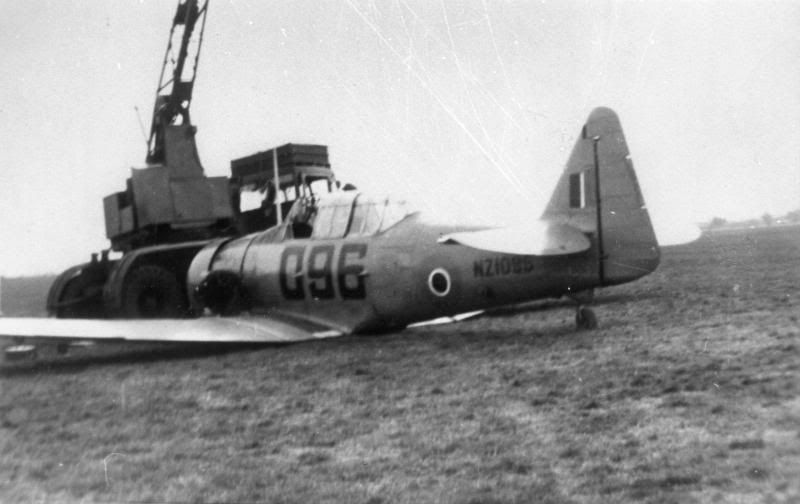 |
|



